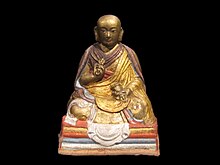Jebtsundamba Khutuktu
| Part of a series on |
| Tibetan Buddhism |
|---|
 |
The Jebtsundamba Khutuktu (Mongolian: Жавзандамба хутагт, Jawzan Damba Khutagt Mongolian pronunciation: [tɕawtsəɴ tampə χʊʰtəxt]; Chinese: 哲布尊丹巴呼圖克圖; Tibetan: རྗེ་བཙུན་དམ་པ་ཧུ་ཐུག་ཐུ་, Wylie: rje btsun dam pa hu thug tu, THL Jetsün Dampa Hutuktu "Venerable Excellent incarnate lama") are the spiritual heads of the Gelug lineage of Tibetan Buddhism in Mongolia.[1] They also hold the title of Bogd Gegeen, making them the top-ranked lamas in Mongolia.
History[]

The first Jebtsundamba, Zanabazar (1635–1723), was identified as the reincarnation of the scholar Taranatha of the Jonang school of Tibetan Buddhism. Zanabazar was the son of the Tüsheet Khan Gombodorj, ruler of central Khalkha Mongolia, and himself became the spiritual head of the Khalkha Mongols.
On May 29, the Jebtsundamba Khutukhtu paid homage to the Kangxi Emperor in 1691 at Dolonnor.[2]
Like Zanabazar, the 2nd Jebtsundamba Khutughtu was a member of Mongolia's highest nobility and direct descendant of Genghis Khan. After Chingünjav's rebellion and the demise of the second Jebtsundamba Khutugtu, the Qianlong Emperor decreed in 1758 that all future reincarnations were to be found from among the population of Tibet.
When northern Mongolia declared independence in 1911, the eighth Jebtsundamba (1869–1924) was elevated to theocratic ruler, called Bogd Khan. He was the head of state until his death in 1924. The communist government of the Mongolian People's Republic, which replaced the theocracy in 1924, declared that there were to be no further reincarnations.
A reincarnation was in fact found almost at once in north Mongolia, and some high lamas of the dead Khutughtu's suite went to interview the child's mother, Tsendjav, and to instruct her in the details of the life of the former incarnation, so that she could familiarize the child-candidate with the tests which he would have to undergo. Faced with the possibility of a new Khutughtu who was born within Mongolia and was not even a foreigner from Tibet, the Central Committee of the Mongolian People's Revolutionary Party decided in July 1925 to turn the matter over to the elderly 13th Dalai Lama in Lhasa. The Dalai Lama's decision would nonetheless be subject to new Mongolian legislation for the separation of church and state. In February 1929, the installation of any further Khutughtus was forbidden.[3]
A 9th Jebtsundamba Khutughtu was installed by the 14th Dalai Lama as the head of a reinvigorated Jonang lineage. He was born Jampal Namdol Chökyi Gyaltsen in 1932 and he died in early 2012. Despite the Chinese government's claim to have inherited the authority and ultimate decision right for the choice of successor of all high lamas in Mongolia and Tibet, the 9th Jebstundamba will be reincarnated within the independent Mongolia and the selection will be confirmed by the Dalai Lama. This puts China in a dilemma of endangering their foreign affairs with Mongolia for the choice of the next Lama or to forfeit this right that they claim to have control of religious affairs, ultimately giving up their authority over the choice of the next Dalai Lama and putting their current choice of the Panchen Lama in question.[4]
List of Jebtsundamba Khutuktus[]

Bogdo gegeen (Mongolian and ceremonial Tibetan language names)
- 1635–1723: Öndör Gegeen Zanabazar (Wylie: Blo bzang bstan pa'i rgyal mtshan), 1st Jebtsundamba Khutughtu
- 1724–1757: Luvsandambiydonmi (Wylie: Blo bzang bstan pa'i srgon me), 2nd Jebtsundamba Khutughtu
- 1758–1773: Ishdambiynyam (Wylie: Ye shes bstan pa'i nyi ma), 3rd Jebtsundamba Khutughtu
- 1775–1813: Luvsantüvdenvanchug (Wylie: Blo bzang thub bstan dbang phyug),
- 1815–1841: Luvsanchültimjigmed (Wylie: Blo bzang tshul khrim 'jigs med),
- 1843–1848: Luvsantüvdenchoyjijaltsan (Wylie: Blo bzang dpal ldan bstan pa), 6th Jebtsundamba Khutughtu
- 1850–1868: Agvaanchoyjivanchugperenlaijamts (Wylie: Ngag dbang chos kyi dbang phyug 'phrin las rgya mtsho),
- 1870–20 May 1924: Agvaanluvsanchoyjindanzanvaanchigbalsambuu (Wylie: Ngag dbang blo bzang chos rje nyi ma bstan 'dzin dbang phyug rJe btsun dam pa Bla ma), 8th Jebtsundamba Khutughtu and Bogd Khan
- 1936–1 March 2012: Jambalnamdolchoyjijantsan (Jampal Namdrol Chokye Gyeltsen), 9th Jebtsundamba Khutughtu (b. 1933; from 1991, recognized by the Dalai Lama; in Tibet exile to 1959, then in India; died in Ulan Bator)[5]
- On November 23, 2016 during a visit to Mongolia, the Dalai Lama announced his belief that the 10th Jebtsundamba Khutughtu had been reborn in Mongolia and that a process for identifying him had begun.[6]
References[]
- ^ Charles Ives Waldo, Jr. "THL Tibetan to English Translation Tool". Tibetan & Himalayan Library. The Tibetan & Himalayan Library. Retrieved 25 February 2015.
khal kha'i bla chen zhig said to be jo nang pa tā ra na tha's reincarnation
- ^ James Louis Hevia (1995). Cherishing Men from Afar: Qing Guest Ritual and the Macartney Embassy of 1793. Duke University Press. pp. 45–. ISBN 0-8223-1637-4.
- ^ C.R. Bawden, The Modern History of Mongolia, 1968, Praeger publishers, New York, pp. 261-263
- ^ "Archived copy". Archived from the original on 2012-03-04. Retrieved 2012-07-14.CS1 maint: archived copy as title (link)
- ^ Tibetan Buddhist Mongolia, Religious Organization, worldstatesmen.org
- ^ Aldrich, M.A. (3 December 2016). "The Dalai Lama in Mongolia: 'Tournament of Shadows' Reborn". www.thediplomat.com. The Diplomat. Retrieved 4 December 2016.
External links[]
- Jebtsundamba Khutuktus
- Gelug Buddhists
- Tulkus